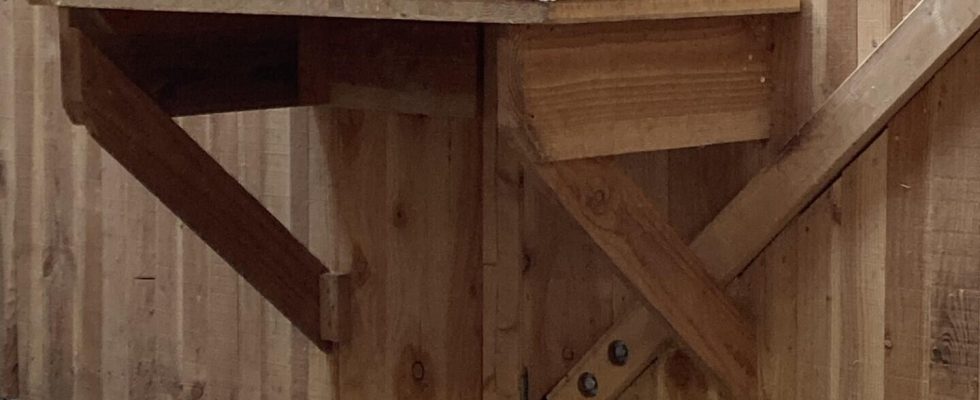The boreal lynx is a large, discreet and little-known predator. This large feline with ears topped with black “brushes” is threatened in France. There are only 150 individuals, mainly in the Jura, in the east of the country. And despite its status as a protected species, the animal is the victim of poaching and road traffic. To help conserve this forest species, the Athénas care center, unique in France, has welcomed lynx in difficulty since 1987.
For lynx, human presence is a source of stress. In order to disturb them as little as possible, the director of the Athénas center, Gilles Moyne, follows what is happening in the enclosures by consulting a video surveillance system via his smartphone. “ Here I see what is happening in the enclosure where we have a young female and an adult femalehe explains, zooming in on the screen. I see that everything is fine, the two are perched on a platform. »
To be able to help lynx in difficulty, the association for the protection of wildlife, created by three enthusiasts in 1987, raised awareness among surrounding residents. A network of 240 sentinel volunteers now report lynx in need of care. They mainly spot them on social networks where those who have encountered a lynx post photos or videos. “ These are either young lynxes who have lost their mother and who, hungry and unable to feed themselves, move closer to the villages. Either adults who have been injured by hunters who refuse to coexist with a deer predator, or adults who have been run over on the road “, explains Gilles Moyne.
Road collisions
Why do these wild animals approach places as noisy as roads? “ We must reverse our way of seeing, reacts the director and co-founder of the Athénas center. This is lynx territory which is crossed by roads and highways. A lynx’s territory covers on average 15 to 20 municipalities, from 130 to 300 km², so there are necessarily communication routes… It’s up to us to be careful. » The lynx normally travels following forests and hedgerows, but many have been destroyed in recent decades. Villages and roads now fragment its space.
The Athénas center is therefore campaigning for the reduction of speed on sections of roads often crossed by lynx and it suggests that municipalities install specific traffic signs there to encourage motorists to be careful.
Also listenBiodiversity: learning to cohabit with the “wild”
“ France today has only 150 lynx, it is a fragile population », continues Gilles Moyne. These forest super-predators, eaters of deer and foxes, had disappeared from France due to human pressure. They returned to the Jura Massif thanks to their reintroduction in Switzerland, the neighboring country. But all these lynxes are coming down of around fifteen founding individuals », underlines the self-taught specialist. They therefore suffer from a loss of genetic diversity: “ this causes fertility disorders, poorer survival of the young, less resistance to environmental conditions. » To remedy this, the association would like the authorities to agree to exchange a French lynx with a German lynx, in order to diversify the genetic heritage.
Eye to eye, with the lynx
This March morning, the center director and his biologist colleague Lorane Mouzon waited for me to feed the lynx. “ I took three rabbits to feed the injured female, for the old male and his enclosure companion, and then pieces of beef for the two females including the young one. », explains Gilles Moyne as he grabs these dead animals, kept frozen in an old refrigerated truck. Arriving at the lynx building, we enter an airlock, pass through a footbath to disinfect our shoes and thus avoid the possible transmission of typhus to the animals. We are soon in the corridor which leads to the lynx enclosures. From now on, you will have to whisper.
Through small, uncolored windows, we see them. An old Siberian male with green eyes and a gray coat surprises us by grabbing the food that Lorane Mouzon throws in the crack of the door. Victim of wildlife trafficking, this lynx is “ too used to humans, that’s why he approaches », she explains.
In the following enclosures, two females born in the nature and who can be released, have a completely different reaction. Flattened on the platform at the back of the enclosure, they try to hide in the landscape, their eyes fixed on us, ready to jump to flee if danger approaches. When we opened the door to drop off her food, Evalude, a female injured in the leg by a hunter, began to growl, her lips swelling as the air passed through her mouth. This face-to-face encounter, even very quickly, is striking.
“ We see lynx every day, but each time, there is still emotionagrees Lorane Mouzon. We spend a lot of time making sure they’re going to be okay and can be released, so release day is the culmination of that teamwork. “, she smiled.
Also listenThe difficult return of the lynx to the Jura
Of the 95 lynx welcomed since the creation of the center in the late 1980s, 27 have survived their difficulties. They were able to be released into the wild to continue to reproduce and thus contribute to the preservation of the species. Back in his office, Gilles Moyne examines a video sent by a sentinel citizen. We see a female lynx with a broken ear. “ An adult with these characteristics was released nine years ago, he whispers, If examining her coat confirms that it’s her, that would be excellent news! »
Also listenIn Europe, the lynx reconquers the West
